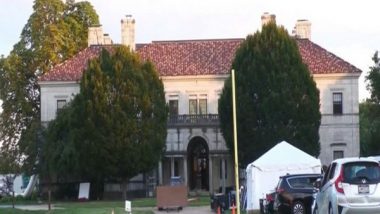On the coast of the Bay of Fundy, in the Musquash Estuary, sits the remnants of New Brunswick's first foray into publicly owned power. The Musquash power station and connected dams were the first generating stations built by N.B.
Power, the province's public electricity utility. It was operational from 1922 until 2009, but historian James Upham says the remnants of the station offer a prime view of the province's power history. "We're looking at a really ambitious, very successful, early undertaking of early power generation in the province of New Brunswick that also just happens to have a beautiful setting," said Upham.

Early power Several early utilities produced electricity in the province, including the Fredericton Electric Light Company, the Moncton Gas, Light and Water Company, and the Eastern Electric Company in Saint John. But all of these companies were relatively small, serving limited areas and leaving the vast majority of the province still in the dark. Before N.
B. Power, several smaller independent companies sold electricity to a small number of New Brunswickers. (The Daily Mail/New Brunswick Historical Newspapers Project) "There weren't a lot of private people that had access to electricity," said Upham.
"There was very little in the way of any kind of grid to move it around the province." This led to discussions in the province about what the future of electricity should look like, whether there should just be private businesses selling power where they felt they could, or if a more widespread solution should be found. Founding of N.
B. Power That was the case until the 1920s when the government realized there was a need to offer more electricity to more people. "After the First World War there was a public perception in New Brunswick that light and power were necessities of life and were therefore the responsibility of the government," wrote Judith House and David L.
Myles in a 1990 history of the public utility. Information Morning - Saint John 11:14 Roadside History - Musquash dam Roadside History columnist James Upham takes us to Musquash, where NB Power built a dam in the years following the First World War. The New Brunswick Electric Power Corporation was thus created by an act of the legislature in 1920.
The founding of the corporation was viewed as overwhelmingly popular, that is if Fredericton's Daily Mail was to be believed. "The power bill is looked upon by many people as the most progressive and useful legislation ever submitted to the New Brunswick legislature," said the Daily Mail in its April 20, 1920, edition. The move to a public utility proved popular.
(The Daily Mail/New Brunswick Historical Newspapers Project) "To provide cheap power for the people of this province has long been a pet hobby of the gentleman who is now the head of the government and he is deserving of hearty congratulations," stated the paper. The gentleman in question was Premier Walter Foster, a Liberal with a progressive track record. His government brought in women's suffrage and the first Department of Health.
Building the complex While the corporation now existed, it didn't actually own any electricity-producing infrastructure. That was to quickly change with the construction of the dams and neighbouring generating station west of Saint John. The future of the corporation was very much tied to the success of the dams, and was put at risk when part of the dam washed away before construction was completed.
The future of the corporation was very much tied to the success of the dams. (Khalil Akhtar/CBC) "When that dam washed out, to some people it looked as though the public commission wasn't doing a very good job," said Upham. But the dam and generating station was a success, delivering power from Musquash all the way to Moncton via a transmission line.
The utility would then start building even more generating stations, including a coal-fired station at Grand Lake in 1931. View of the past The Musquash complex has been decommissioned since 2009, but several of the buildings and dams still stand on the site. Upham says they are still an imposing sight on the landscape, especially when you consider that they were built without modern construction equipment.
The complex 'was built to a great degree by muscle — human muscle, horse muscle, people hauling and lugging,' says historian James Upham. (Khalil Akhtar/CBC) "Like a lot of the stuff that we look at from this era, we're standing on a thing that was built to a great degree by muscle — human muscle, horse muscle, people hauling and lugging," said Upham. "That is actually quite a thing to have built.
It's impressive.".



















